
Miho Shimizu is a Japanese freelance writer settled in Shizuoka with her husband and two rabbits. Fascinated with traveling at the age of 18, she has spent most of her long holidays exploring incredible spots around Japan. She also loves to listen to music, draw, and read novels over a cup of green tea.
This post may contain some affiliate links. When you click through and make a purchase we may receive some commission, at no extra cost to you.
If you are looking for some easy recipes to whip up a quick and delicious lunch or dinner tonight, you’ve come to the right place! Although some traditional Japanese dishes are indeed difficult to make at home, there are also simple dishes that you can easily make on your own on a limited budget that require few ingredients and can be prepared in a short amount of time! These dishes are also very healthy and make use of various vegetables which will help busy parents make sure the kids get their daily dose of greens. Here we’ve picked 10 easy and tasty Japanese appetizers and side dishes that you can make at home!
1. Japanese Cucumber Salad (酢の物)

Our list starts with a type of healthy salad made with very affordable ingredients which could be a perfect side dish for your dinner tonight! Japanese cucumber salad, also known as sunomono (酢の物) in Japanese, is a lightly pickled salad made with vinegared cucumbers. What you need to prepare are simple ingredients and seasonings that can be found at any supermarket in Japan. This traditional dish has a refreshing taste of vinegar and is surprisingly low in calories, making it an ideal side dish for those who are calorie-conscious or want to eat something light in summer. In Japan, some people also like to add extra ingredients such as tuna mayo, wakame seaweed or boiled octopus.
Japanese Cucumber Salad Recipe
Ingredients:
- Cucumbers
- Vinegar
- Salt
- Sugar
- Sesame seeds
Extra ingredients (optional): boiled octopus, wakame seaweed, tuna mayo
1. Remove the skin from the cucumbers and slice them
2. Sprinkle salt over the sliced cucumbers and gently rub it in
3. Remove extra moisture from the surface of the cucumbers with a paper towel
4. Mix vinegar, salt and sugar in a bowl
5. Add the sliced cucumbers and extra optional ingredients to the bowl and mix together
2. Ohitashi (おひたし)
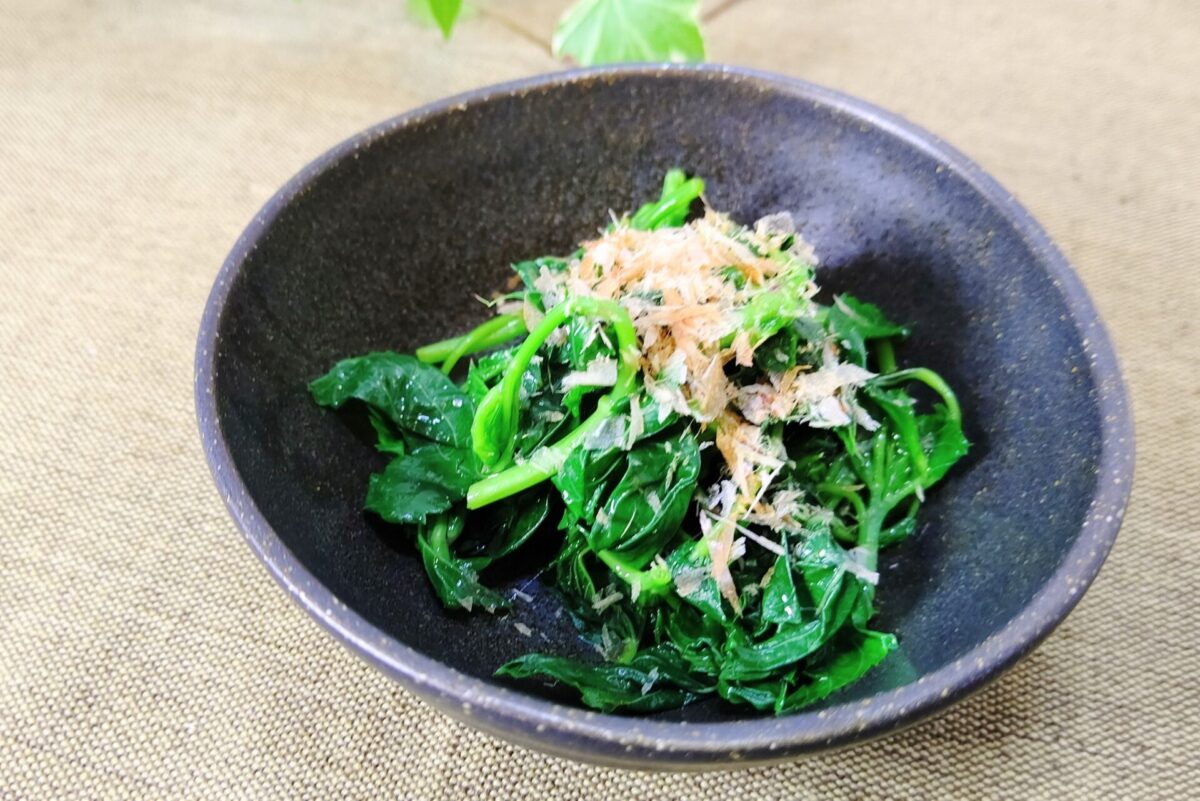
Ohitashi is a traditional Japanese side dish which is not only easy to make, but also healthy and very flavorful! The recipe of ohitashi is very simple, and even those who don’t cook regularly will feel comfortable making it. Ohitashi consists of boiled spinach, typically served with katsuobushi (dried bonito flakes) and a little soy sauce. If you want to enhance the culinary experience, you can alternatively use dashi broth instead of soy sauce. Spinach contains a lot of beneficial nutrients, including dietary fiber, vitamin and iron which is essential for those who are suffering from anemia. Some people also use other kinds of vegetables to make ohitashi, such as nanohana (rape blossoms) and hakusai (Chinese cabbage).
Ohitashi Recipe
Ingredients:
- Spinach
- Katsuobushi (dried bonito flake)
- Soy sauce
- Salt
1. Wash the spinach carefully with water (cut off the stems if you prefer)
2. Boil the spinach with a pinch of salt until they get soft (approximately 1 minute)
3. Put the spinach in cold water and then squeeze out the water
4. Cut the spinach into bite-size length
5. Put the cut spinach on a plate, drizzle with soy sauce and add some katsuobushi on top
If using a dashi broth instead of soy sauce, you need to prepare the dashi broth before boiling the spinach. The ingredients in dashi broth are dashi soup (soup stock), soy sauce and mirin (sweet cooking sake).
3. Hiyayakko (冷奴)
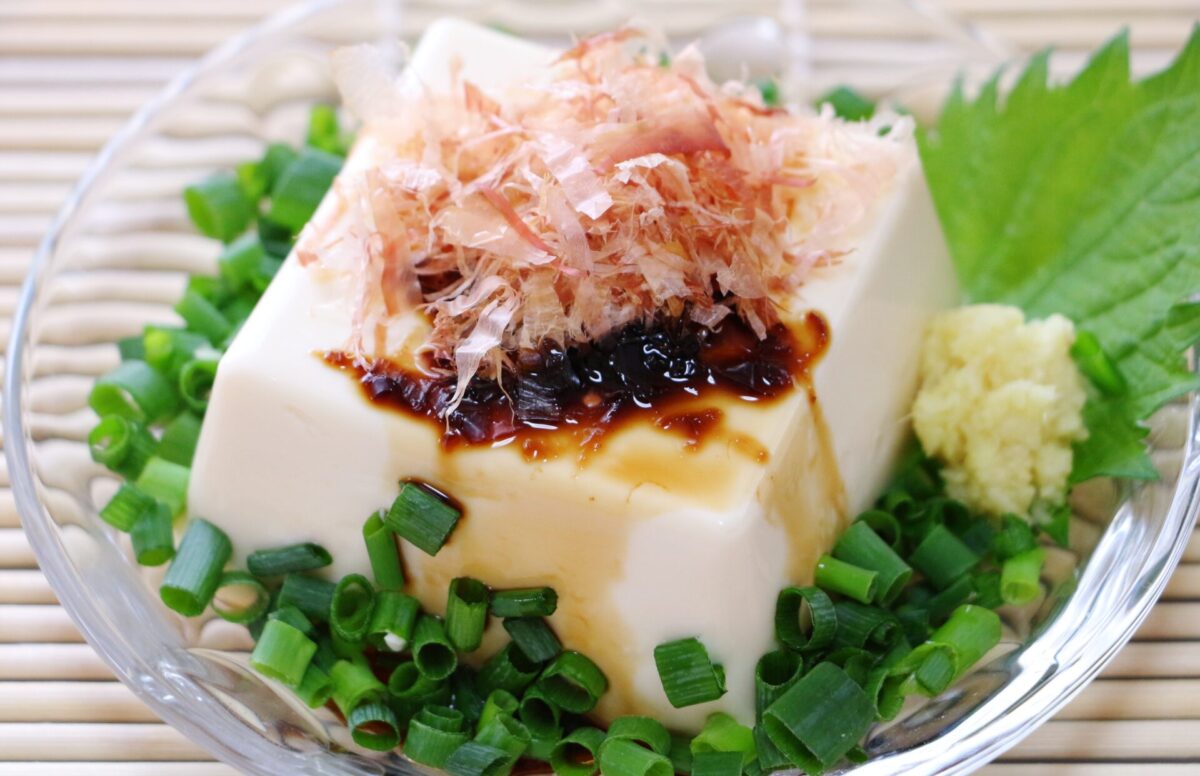
Hiyayakko is a simple way to enjoy the natural flavor and texture of tofu. Many of you might think of tofu as a common ingredient in miso soup, but it is actually also enjoyed as a popular side dish in Japan. Hiyayakko is chilled tofu which is then served with various toppings, including chopped green onions, katsuobushi (dried bonito flakes), soy sauce and grated ginger. Hiyayakko is a perfect side dish or appetizer to enjoy all year round, but particularly in summer or when you want to have a refreshing snack with your beer.
Hiyayakko Recipe
Ingredients:
- Tofu (kinudofu – silken tofu – is the best type of tofu for hiyayakko because of its smooth texture)
- Chopped green onion
- Katsuobushi (dried bonito flakes)
- Grated ginger (optional)
- Soy sauce
1. Cut the block of tofu into your preferred size for eating
2. Add the toppings according to your liking
3. If the tofu is not cold enough, keep it in the fridge for a couple of minutes before serving
4. Agedashi Tofu (揚げ出し豆腐)
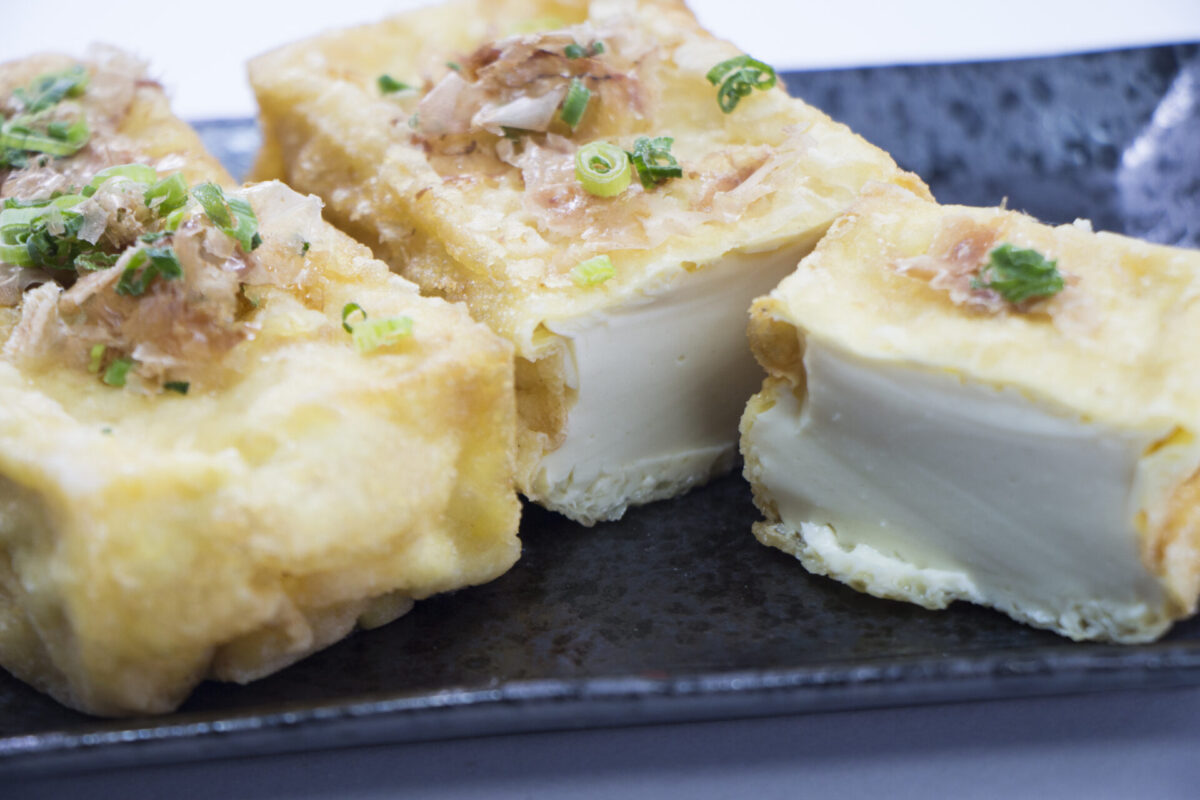
Another common way to enjoy tofu is agedashi tofu: deep-fried tofu which is often served as a side dish in Japanese homes and as a tasty appetizer at many restaurants in Japan. Unlike ordinary soft tofu, agedashi tofu has a crispy texture on the outside as it’s covered with crunchy potato starch. Once you bite through the coating, however, you will find the fluffy texture of soft tofu inside. Agedashi tofu is typically served in a savory dashi broth with flavorful toppings such as grated ginger, grated radish, chopped green onion and katsuobushi (dried bonito flakes). It’s a side dish that perfectly pairs with any kind of refreshing drink such as beer or nihonshu.
Agedashi Tofu Recipe
Ingredients:
- Tofu (momendofu – firm tofu – is the best type of tofu for this dish)
- Potato starch
- Chopped green onion
- Katsuobushi (dried bonito flakes)
- Grated ginger
- Grated radish
- Dashi broth (dashi soup stock, soy sauce, salt, mirin)
- Cooking oil
1. Cut the block of tofu into your preferred size for eating
2. Leave the tofu on a paper towel for 5-10 minutes to remove excess moisture
3. Lightly coat the tofu with potato starch
4. Prepare the dashi broth and boil it in a saucepan for a couple of minutes
5. Preheat some oil to 170℃ in a deep pan, add the tofu and deep-fry for a few minutes (typically 2-3 minutes) until the tofu turns light brown
5. Ochazuke (お茶漬け)
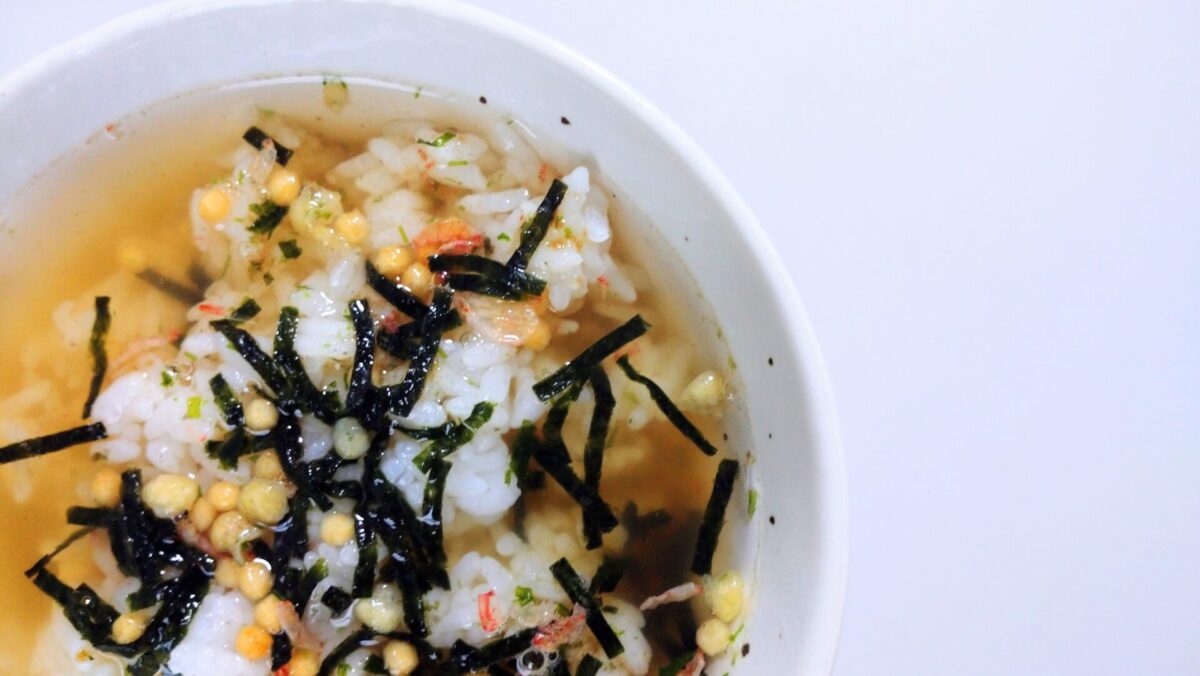
Ochazuke is a great option when you don’t feel like cooking anything, but need to fill your empty stomach quickly and easily! Ochazuke is a traditional Japanese dish which is made by soaking cooked rice in hot green tea and adding savory toppings. These days, however, most people use ochazukenomoto (premade seasoning powder for ochazuke) which can be found at supermarkets nationwide. It typically contains green tea powder, crispy mini rice crackers and seaweed flakes. Ochazuke is often chosen as a quick breakfast for a busy morning, a light lunch when you have got nothing left in your fridge or a final order to finish off your meal at izakaya bars or casual restaurants.
Ochazuke Recipe
Ingredients:
- Cooked rice
- Ochazukenomoto
- Hot water
If you want to make ochazuke from scratch without using ochazukenomoto, prepare cooked rice, hot green tea and your favorite toppings instead.
1. Put cooked rice in a bowl
2. Add ochazukenomoto (or your favorite toppings – salmon flakes and pickled plums make for great ochazuke toppings)
3. Pour hot water (or hot green tea) over the rice
6. Natto (納豆)

Natto is fermented soy beans and has been a staple in Japanese cuisine for centuries. The strong smell and sticky texture of natto might be challenging for some foreigners at first. The best and simplest way to enjoy this unique Japanese dish is to put natto on rice and mix them together with soy sauce. You can also add some toppings such as chopped green onions, raw eggs or avocados which will make the strong flavor more mild. At supermarkets in Japan, you can easily find a wide variety of natto with different flavors such as plum, shiso (Japanese herb), and oroshi daikon (grated Japanese radish). Natto is also rich in essential nutrients, including soy isoflavones, protein, vitamins and minerals, which help our bodies grow stronger and stay healthy!
Natto is difficult to make from scratch, so it is common to buy it at supermarkets.
7. Oden (おでん)
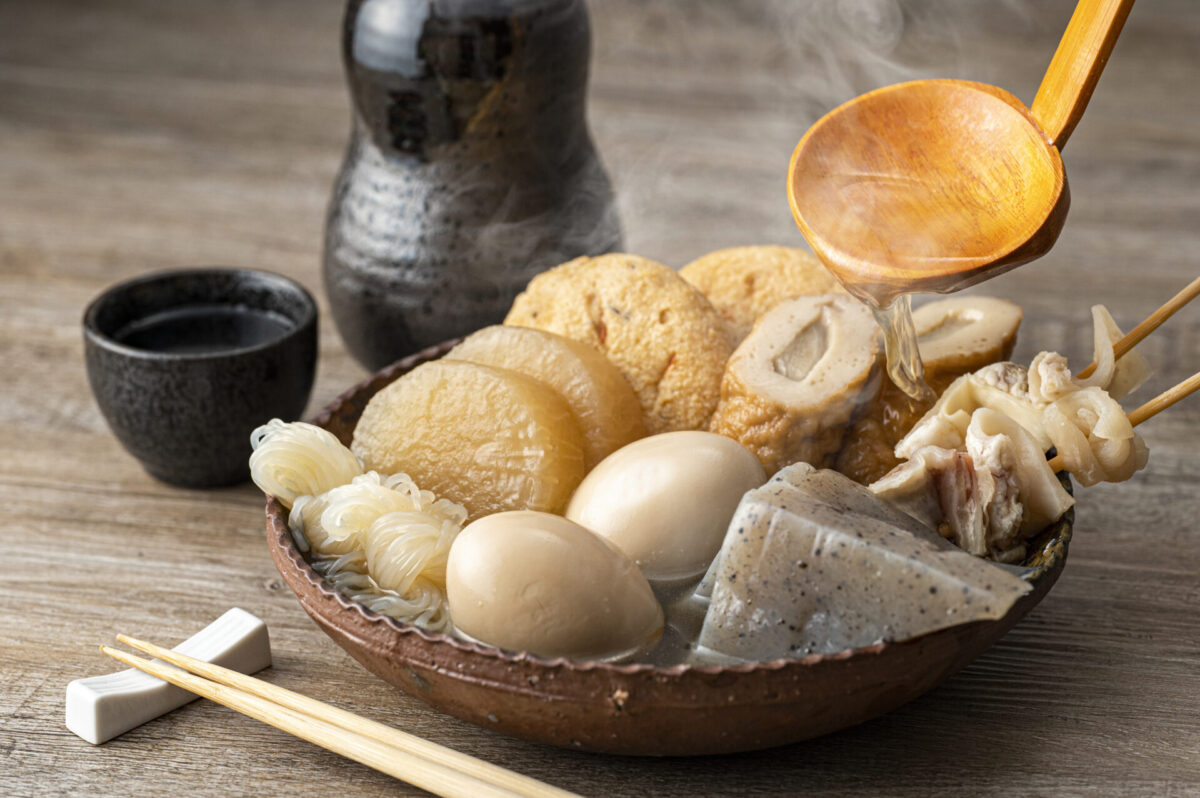
Oden is a simmered dish which is often eaten during the cold winter season. This unique dish typically contains a variety of ingredients such as boiled eggs, daikon (Japanese radish), fish cakes and konjac (a firm jelly made from yam roots). All the ingredients are simmered together in a hot pot with a tasty dashi broth. Oden is sold at convenience stores in Japan from autumn to early spring. All the items are sold individually for an affordable price (typically around 100 yen) which is perfect if you want to have oden, but don’t have all the necessary things to make it at home. Oden is easy to make without any special cooking skills or techniques, and eating oden in winter will keep you warm!
Oden Recipe
Ingredients:
- Dashi broth (dashi soup stock, soy sauce, sugar, mirin)
- Boiled eggs
- Daikon (Japanese radish)
- Nerimono (fish cakes)
- Konjac
1. Put the dashi broth in a hotpot
2. Remove the skin from the daikon, boil the eggs and cut the konjac into bite-sized pieces
3. Add all the ingredients to the hotpot
4. Simmer on low heat until all ingredients are soft
8. Onigiri (おにぎり)
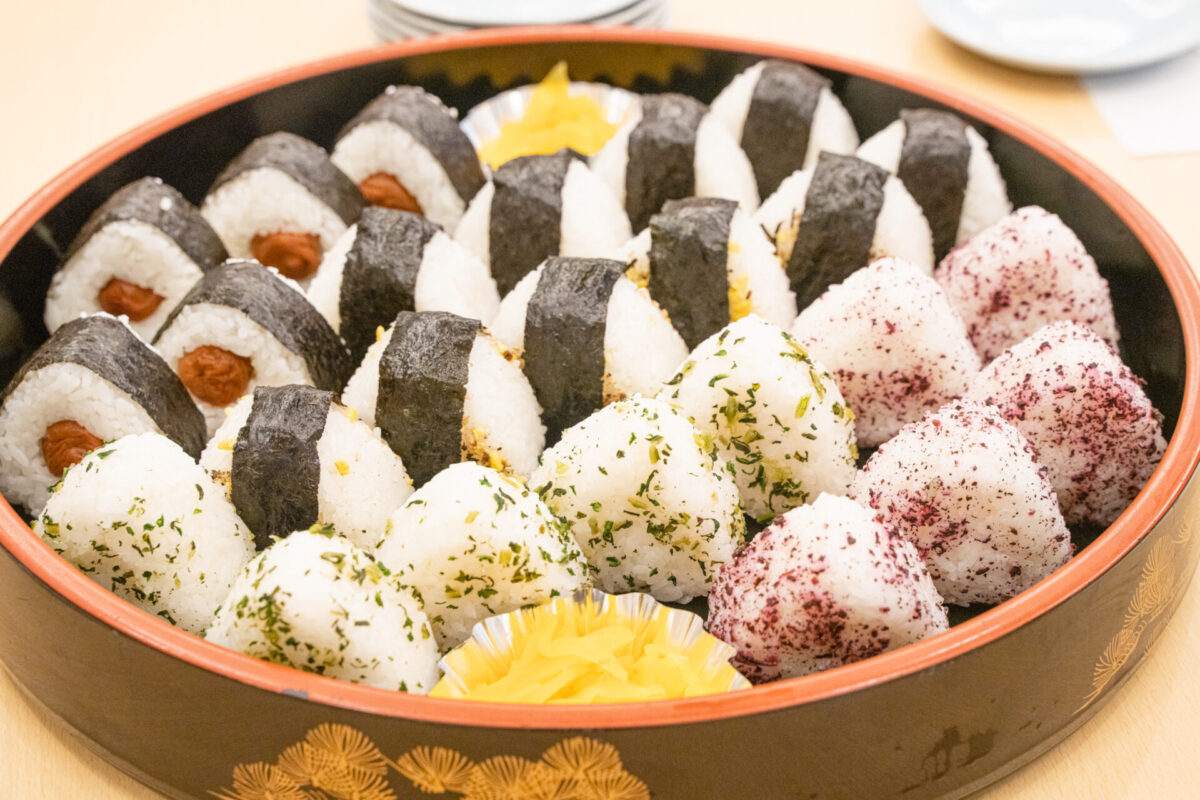
Onigiri is a Japanese rice ball and is one of the most popular snacks in Japan. If you have ever visited Japan, you have probably stopped at a convenience store and bought an onigiri as a cheap and quick meal. Onigiri can have different shapes (typically triangular or round), flavors, prices and fillings depending on where you buy them. Onigiri are also a common addition in lunch boxes as they are easy to make with simple ingredients available in any ordinary household in Japan. Popular fillings for onigiri include salmon, pickled plum, tuna mayo (mixture of tuna and mayonnaise) and bonito flakes. If you have children and want to spark their interest in Japanese food, making onigiri together at home can be a fun activity!
Onigiri Recipe
Ingredients:
- Cooked rice
- Water with a little salt added
- Dried seaweed (long enough to wrap around the rice balls)
- Fillings of your choice (pickled plums, salmon, bonito flakes, tuna mayo)
1. Wash your hands and wet them in the salty water (this will prevent the rice from sticking to your hands)
2. Take a handful of rice with one hand
3. Form the rice into your preferred shape (triangular or round) using both hands, and then make a hole in the middle
4. Place the fillings in the hole and completely cover the hole with rice
5. Wrap your onigiri with dried seaweed (optional)
9. Miso soup (みそ汁)
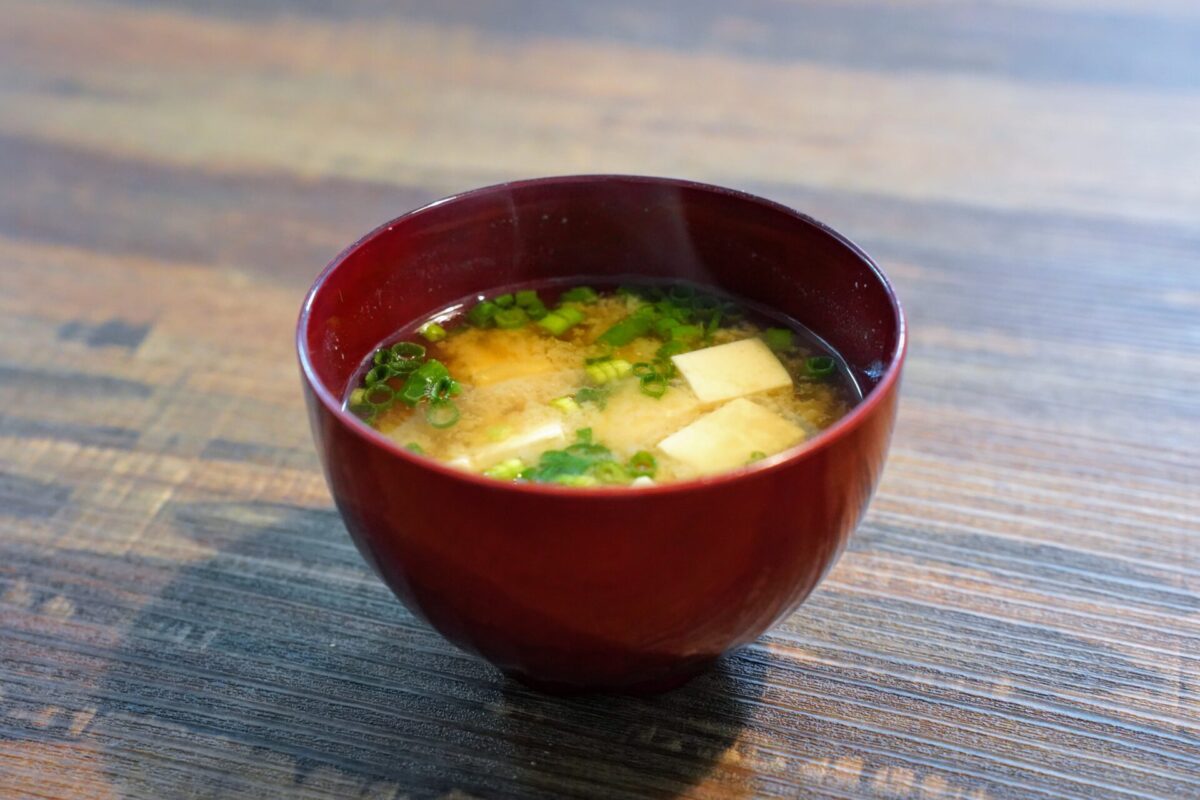
Miso soup is part of practically any traditional Japanese meal. The soup is made with miso paste and dashi (bonito broth). Miso soup is savory, mild and a little salty. Tofu, wakame (a type of seaweed), chopped green onions, asari clams and aburaage (fried tofu) are things that are often added to miso soup. You can easily find these ingredients sold cheaply at supermarkets anywhere in Japan. As you savor your first sip of this flavorful soup, you will soon fall in love with the taste which pairs perfectly with white rice or rice balls!
Miso Soup Recipe
Ingredients:
- Miso paste
- Dashi powder (bonito broth)
- Water
- Your preferred add-ins (tofu, wakame, asari clams, aburaage, chopped green onions)
1. Boil the water and add dashi broth powder
2. Stir until the dashi broth powder is completely dissolved
3. Add your preferred toppings
4. Turn off the heat and add miso paste with a ladle
5. Using a whisk or fork, gently mix the miso paste with the boiled water until it’s completely dissolved
6. Turn on the heat again (low to medium heat) and boil for a couple of minutes
10. Tsukemono (漬物)
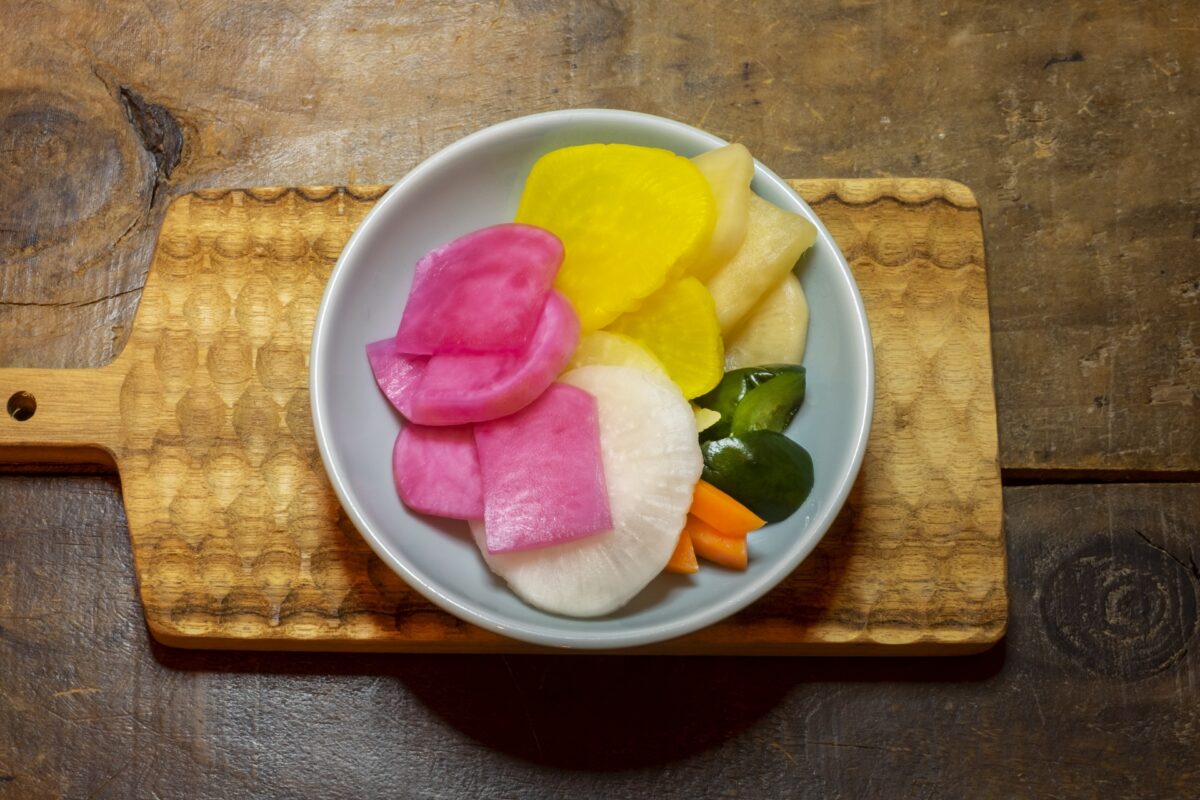
Tsukemono is Japanese pickled vegetables and is an important part of traditional Japanese meals along with white rice, miso soup and grilled fish. In Japan, people use many different types of vegetables to make tsukemono, including radishes, eggplants, cucumbers, carrots and turnips. If you have had teishoku (定食) – set menu meals available at casual restaurants in Japan – your order might have come with a small plate of yellow radish pickles called takuan (たくあん). Some people also enjoy making their own tsukemono at home with their favorite vegetables.
Tsukemono Recipe (Quick Pickled Vegetables)
Ingredients:
- Fresh vegetables of your choice (cucumbers, Chinese cabbage and carrots are some of the best vegetables for making tsukemono)
- Salt
If you have any of the following ingredients in your kitchen, using them will add extra flavors and textures to your homemade pickles!
- Salted kelp
- Pepper
- Katsuobushi (dried bonito flakes)
1. Cut or slice vegetables into bite-sized pieces
2. Put them in a plastic bag or plastic container with some salt (you can add salted kelp or pepper if you like)
3. Rub the salt into the vegetables
4. Leave the vegetables in the fridge for 12-24 hours before serving
Cooking dishes from other countries is a great way to understand the country and its food culture better. Some of the ingredients used in the recipes above might be new to you, such as dashi and katsuobushi which are the secrets behind many Japanese dishes. Luckily, most of them are cheaply priced and easily found in supermarkets across Japan. If you want to make Japanese dishes using professional kitchen utensils, getting a Japanese knife can be a great idea and will help you prepare the dishes much faster!
Japanese Home Cooking Experience
airKitchen offers a variety of cooking experiences in Japan where you can learn not only the recipe for Japanese meals but also Japanese culinary culture. A host will invite you to their home kitchen! If you want to master Japanese home cooking meals, we highly recommend airKitchen’s cooking experience to add to your itinerary.
- Traditional Japanese food (Tokyo)
- Japanese home-cooked meal (Osaka)
- Assorted vegan plate based on Shojin ryori (Kyoto)


Japan Wonder Travel Food Tours
Japan Wonder Travel is a travel agency that offers guided tours throughout Japan.
From private walking tours to delicious Food and Drink tours, we can help organize the best tours just for you! If you want to explore Japan and learn more about the history and backstories of each area you are traveling in, our knowledgeable and friendly guides will happily take you to the best spots!
In addition, we can provide you with any assistance you may need for your upcoming trip to Japan, so please feel free to contact us if you have any questions or need some help!
▶Tokyo Tsukiji Fish Market Food and Drink Tour
Explore the most lively and popular fish market in Tokyo where you will have the chance to try some of the local’s favorite street foods and sake along with your friendly English speaking guide!

▶Shinjuku Bar Hopping Tour: Experience Tokyo’s Nightlife in Izakaya
Check out the best spots in Shinjuku while bar hopping through the lively and vibrant area. Try some delicious local food and drink as you explore the narrow yet photogenic alleys that the town has to offer. Experience Japanese izakaya culture and drink in Shinjuku like the locals!

▶Explore Nishiki Market: Food & Culture Walk
If you’re looking to learn more about the culture and the local cuisine of Kyoto, this is the perfect tour for you! Take part in this Kyoto food and drink tour and explore the 400-year-old market and the surrounding areas.

Follow us on Instagram, Facebook, Twitter, and TikTok for more travel inspiration. Or tag us to get featured!
Happy traveling!
Stay informed of the best travel tips to Japan, the most exciting things to do and see, and the top experiences to have with the Japan Wonder Travel Newsletter. Every week we will introduce you to our latest content.





